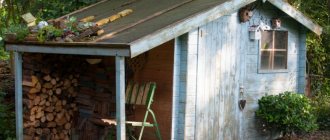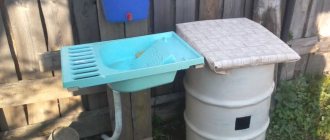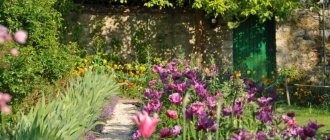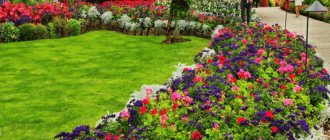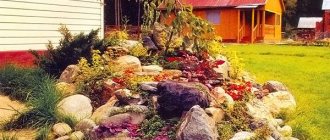According to one famous Italian musician, one should go to the Alpine mountains not with the goal of conquering them, but for inspiration. Mountain meadows are very beautiful in spring. At this time of year, flowering plants, boulders and snowy peaks create an unusual, mesmerizing contrast. Apparently, the desire not to part with this beauty prompted people to create a special kind of flower garden - a rock garden. You can arrange it at your dacha, on your personal plot, in the park of a private holiday home and even in a city park.
What is a rock garden
Alpine slides come in different styles and sizes, but have one main distinctive feature: they always combine mountain vegetation and stones. When constructing a rock garden, two approaches are used: a hill is created artificially on an initially flat area, or natural elevation differences in the area are used. For the first method, in addition to stones, you will need soil, crushed stone or construction waste, from which uneven landscapes are created. In any case, you can create an alpine slide yourself.
Types of rock gardens:
- Rocky hill. The stones are piled up in the form of a hill of arbitrary configuration, on top of which a piece of rock is installed, imitating a mountain peak;
- Terraced garden. Flat stones, mostly flagstone, form several tiers resembling wide steps;
- Czech rolling pin. Flat stones are laid “on edge”, forming a kind of relief of parallel ridges. The space between the rows is only half filled with sand and soil so that the stone ridges rise above the soil.
Making a Czech rolling pin - Supporting wall. Skilfully decorated to resemble a mountain landscape, a rock garden of this type serves to strengthen the slopes on the site.
You can create a slide using a minimum number of stones or no stones at all. Various types of clay pots with unpretentious vegetation are placed on several levels. The advantage of such a flower garden is its mobility (you can always change the composition by rearranging the flowerpots), as well as its ease of care (no need to fight weeds).
Preparation
Despite the fact that each rock garden is an independent and completely unique solution, there are certain design standards.
It is very important to prepare the ground at the very beginning
The importance of preparatory work is not even in doubt. If this is not done, the alpine slide at the dacha with your own hands is unlikely to be stable. We pay special attention to the dryness of the place chosen for the construction of the rock garden. The lower the groundwater is, the stronger and more durable the structure will be. Their level can be lowered if special drainage is made during the preparation process.
How to make drainage
- Dig a pit the same size as the area of the garden slide with your own hands. Before this, it is advisable to make precise markings using pegs and a cord. The pit depth is at least 80 cm.
- Fill it first with crushed stone, then with pebbles or broken bricks (height 30 cm or more). Each layer is wetted with water.
- Add the sand and gravel mixture on top of the gravel layer, water thoroughly and tamp down.
- The soil that was removed from the pit must be cleared of debris and stones. It is placed on top of the drainage. Visual photos will help you navigate the order of work. You can also purchase soil for the slide at the store, or make it yourself. The soil cleared of weeds is mixed with peat (ratio 3:1). If possible, gravel (5:1) is added to the ready-made mixture.
- Stones as a base are allowed to be laid only after 2-3 weeks. During this time, the earth will settle down well. Sometimes summer residents do the following. They begin construction in the fall and then leave it over the winter to allow the soil to effectively settle.
- After shrinkage, the formation of the supporting structure begins. First of all, you need to install the largest and most voluminous boulders. They are installed around the perimeter, with 60% of the volume or more buried in the ground. We place small stones in such a way that precipitation cannot erode the structure. It is important that all stones are harmoniously combined with each other. We leave some free space between them for planting plants.
We also recommend reading
- How can a dry stream transform your dacha?
- How can vertical gardening transform your home?
Preparatory work and laying out stone (video)
How to choose a place for a rock garden
An alpine slide is not a “duty” flower bed, which is designed to fill empty space. It is created with the aim of giving the site a special style and drawing attention to the original composition. In this regard, the most visible, visible place is chosen for the flower garden. For example, it can be placed near the main path, close to the curb or no more than 1 meter away from it.
If the distance is greater, then particularly interesting details may not be visible. The exception is large high slides that occupy an area of more than 5 square meters. m. In their case, between the path and the rock garden, you can make a neat, trimmed lawn up to 2 m wide.
A suitable location is near a gazebo, patio or barbecue area.
This arrangement of the rock garden allows you to enjoy the pleasant scenery while relaxing.
It can also be created in the front garden between the house and the fence, and if the yard area allows, then opposite the front door or in the most conspicuous corner.
Helpful advice! You should not arrange a flower garden under the crowns of tall deciduous trees. In autumn it is very difficult to rake out fallen leaves stuck between the stones. Also, using a rake can damage the stems of creeping plants or accidentally pull them out by the roots.
Classification of rock gardens
If you show patience and hard work, creating a rock garden with your own hands will not be difficult. Below we discuss in detail how to independently plan and create an alpine slide.
Particular attention should be paid to the main element of this decoration, which is a series of stones of different sizes and shapes. It is conventionally called “gray silence”. A group of gray stones needs to be harmoniously diluted with vegetation, which should combine conifers, saxifrage and cover species. They are the most characteristic of alpine terrain.
A group of stones is harmoniously diluted with vegetation
It is extremely important to maintain naturalness when creating a rock garden with your own hands. To do this, stones and plants should be placed in a strict form, but at the same time quite chaotic. Everything should look the same as in its natural environment.
The rock garden should look natural
Alpine slides are usually divided into several types. This is due to the selected material and the shape of its arrangement. Depending on this, these elements of landscape design are divided:
- on rock gardens with a stream;
- mountain slopes;
- small swamp;
- Alpine meadow;
- forest ravine;
- Japanese garden.
For a complete understanding, it is necessary to consider each of the types listed above.
Rock garden with stream
This type is ideal for people who are lucky enough to have a natural stream or small pond on their own territory.
To create an attractive rock garden with your own hands, you need the following:
- Place round stones at the bottom of a reservoir or stream; the small area adjacent to the reservoir should be chaotically decorated with stones and fern-like plants (one of the most moisture-loving and visually attractive);
Fern-like plants are ideal for a rock garden with a stream
- the arrangement of stones and vegetation should look natural;
- with a competent approach and if there is a desire, an existing stream can be transformed by making it a waterfall or a rapids cascade;
The stream can be transformed into a rapids cascade
- In the coastal area of a stream or waterfall, ostrich fern, a species of fern widespread in the wild, will look ideal. This species differs from its analogues in its wide, feathery leaves and reaches a height of 1 meter. This plant will create an atmosphere of wild nature on the alpine hill.
The ostrich will create an atmosphere of wild nature on the alpine hill
mountain slope
This type of rock garden can please the owners of areas with natural relief varieties, such as small hills, with their appearance. Visually, they should resemble natural mountain screes with a random arrangement of stones of different sizes and shapes.
Rock garden imitating a mountain slope
The bouquet of vegetation when decorating an alpine slide should not include large plants. Dwarf pines or junipers are good choices. If desired, they can be diluted with ferns, which against their background will look quite impressive, creating the image of a wild area.
Juniper for alpine hills
Small swamp
Almost all people who are interested in improving the site despair when they discover a swampy island on their land, especially if attempts to drain it were in vain. However, this disadvantage can be turned into a significant advantage. To do this, you need to turn the swamp into a rock garden.
A marshy area can be turned into a rock garden
In the center of this unfavorable area it is necessary to dig a small pit and cover it with pebbles, stones and sand. Through natural processes, this pit will quickly fill with water and turn into an attractive pond. Its appearance will be well complemented by plants characteristic of swampy areas. These include swimsuits. The root system of these flowers is located under water, and the leaves and large flowers float on the water. Recently, a hybrid variety of swimsuit, which is characterized by bright yellow or orange flowers, has become very popular.
The swimsuit will complement the appearance of the pond
With proper attention, this problematic part of the site can be improved beyond recognition by creating an amazing rock garden on it.
Alpine meadow
Creating this type of rock garden with your own hands will not require significant effort from the owner of the site. This alpine hill is a small area of green meadow with various flowers, which smoothly transitions to a rocky mountain slope. In this area it is necessary to plant silky types of grasses that are characteristic of mountainous areas. On a green background, colorful violets, forget-me-nots, primroses, red or yellow myringue, pink saxifrage, golden buttercups and others will look ideal.
Alpine slide
Forest ravine
Creating this type of rock garden with your own hands requires the presence of an appropriate landscape in the form of a small ravine on the site. It should serve as a support for stones, between which plants that do not require an abundance of sunlight should be located. Between large stones at the bottom of the hollow, you can make an artificial spring, which will complement the appearance of the rock garden. For a forest ravine, ideal plants would be various varieties of Japanese maple, the nobility of which will be successfully complemented by pine needles, juniper or fern.
Forest ravine
Japanese garden
This type of alpine slide will be an ideal place for lovers of quiet creation of natural beauty and philosophical reflection. Creating such a rock garden with your own hands does not require a large amount of materials. He is characterized by minimalism. The main thing is to convey the flavor of the countries of the rising sun.
A Japanese garden should convey the flavor of the land of the rising sun.
To do this, it is necessary to place several coniferous plants on the selected site. The space between them must be filled with a small number of relatively small stones. Their arrangement should be well planned, but despite this, they should look natural. Boxwood can be planted next to the stones. Moss-covered stones will create the indescribable illusion that they have been lying in these places since time immemorial.
Japanese-style rock garden
Stages of creating a rock garden
From the area allocated for the rock garden, a layer of soil up to 30 cm is removed, the roots of weeds are cleared, and a crushed stone or gravel cushion is placed in this place.
Instead of crushed stone, you can use broken bricks and fragments of building blocks. This will be drainage that will not prevent moisture stagnation. This stage is important because the vegetation in the rock garden is mostly drought-resistant and does not tolerate waterlogging of the soil.
The next stage is modeling the mountain landscape.
An embankment is made from small stones, crushed stone and earth. The largest stone blocks are placed on it first, and the space between them is filled with smaller parts. During the process of laying stones, you need to inspect the slide from time to time from a certain distance in order to make changes in time if necessary.
Advice. It is recommended to dig some boulders into the soil to a third of their height, or add soil under them. This technique contributes to a more natural, natural landscape.
The structure is spilled with water and left for two weeks. During this time, the soil will shrink under the weight of the blocks, and the hill will be ready for planting.
Choosing a location
When choosing a place to create a rock garden on your plot of land, you need to take into account that you are creating an accent designed to decorate your garden, therefore, it is necessary to place the alpine slide in an open space so that it is an area with a good view from all sides. As a rule, an alpine slide is laid out in the center or on the edge of a grass lawn. It is best to orient the rock garden to the south or southwest - this way it will be well lit by the sun and receive a sufficient amount of heat.
An alpine slide in the center of a green lawn will become a dominant element in the landscape design of your site
The terraced alpine slide will harmoniously fit into the natural topography of the garden
When laying an alpine slide, it is necessary to avoid places adjacent to buildings and in the shade of massive trees, however, shrubs or trees may be present in the background, at some distance, to create a backdrop for the spectacular perception of the rock garden. It’s not bad when the rock garden is integrated into the existing landscape of the land, located on a gentle slope or in a ravine, fitting into the natural differences in elevation - lowlands and hills of the site.
Strive to ensure that the trees and shrubs in the background of the rock garden are uniform in color. A colorful background will distract from the integral perception of the alpine hill as an accent element of the landscape of the site.
The staircase leading up the slope can be beautifully complemented by an alpine slide that imitates a rocky landscape
The starting point for creating a rocky slide can be a diagram of a rock garden, drawn to scale, where you will first plan the placement of stones and planting. If the rock garden is supposed to be placed in the depths of the garden, you need to think through the paths and paths leading to it.
A bench, lost in the depths of the garden, surrounded by a wild corner of nature originally from the Alps, can be a wonderful place for a secluded relaxation
It looks spectacular when an alpine hill is crossed by a rocky winding path or a dry stream of small stones, and nearby there is a bench or grotto with a bench, from where you can admire the result of your landscape creativity.
The rock garden looks great in tandem with a small lake overgrown with reeds and water lilies
A rock garden with a pond looks very harmonious, especially if it is a slightly swampy body of water with characteristic moisture-loving plants planted along the shore. An interesting solution for designing a pond would be to plant a large tree or coniferous bush on a tiny “patch” of land adjacent to the water. This technique will visually expand the boundaries of the site.
A rock garden created from huge stone blocks in combination with a small waterfall will truly decorate your garden
An effective accent of an alpine slide combined with a pond can be a small waterfall falling from an artificial gorge or a stone wall.
Rock garden stones: which ones to choose, how to lay them
Any stones of natural origin are used in the construction of an alpine slide. The most commonly chosen stones are granite, sandstone, limestone, dolomite, travertine and other common rocks.
Sandstone
Less commonly - quartz, serpentine, serpentinite. From a practical standpoint, it is easier and cheaper to purchase those types of stones that are mined in the immediate vicinity. Stone blocks can be of different sizes, but designers recommend that they be of uniform texture and color, ideally of the same breed.
The method of laying stones depends on the type of composition. On a high hill they are laid from bottom to top. In the foreground are the most beautiful medium-sized boulders. They form a kind of barrier that keeps the soil from crumbling. Next, all the details are arranged in accordance with the drawn up plan.
Useful tips
The above instructions for building a rock garden with your own hands will help anyone who wants to create on their own territory a true work of landscape design art that will delight you with its appearance all year round. However, in addition to the previously listed tips and recommendations, there are a number of useful tricks that will make it possible to simplify the process of creating an alpine slide as much as possible, as well as make it as attractive and organic as possible:
1. Stones for a rock garden must be of the same type so that its landscape looks as natural as possible;
Try to select stones of the same type
2. The size of the stones should depend on the area allocated for the rock garden. The larger the area, the larger the boulders can be used to create a flower garden;
3. Particular attention should be paid to the choice of plant species. The best ones will be those that are continuously covered with a variety of flowering spots. In addition, it is worth paying close attention to the timing of their flowering;
4. It is better to give preference to evergreen varieties of low-growing flowers. In this case, there is no need to remove fallen leaves, which often fall between boulders;
Choose low-growing evergreens
5. Several low-growing coniferous plants located between the stones look very beautiful. The rock garden can also be diversified with creeping plant species with small flowers. In addition, it is worth considering cover plants to achieve greater decorativeness of the slide;
6. When building a rock garden with your own hands, it is permissible to use stones of non-natural origin, such as concrete or brick. Saxifraga may well grow from the cracks between them, and moss - on their surface. In addition, if desired, you can use ceramic tiles, artificial stone made of colored resin, as well as small decorative glass stones, which fit quite well into the design of reservoirs;
7. Regarding the choice of plants, the owner of the site is also given complete freedom. When decorating a rock garden with your own hands, it is allowed to use flowers that have nothing to do with the alpine climate. Among the most common types are lilies, roses, calendula, violas, and strawberries. This approach can add genuine individuality to the style of the future slide. The main thing with this improvisation is to follow the basic rules for landscaping a rock garden with your own hands, namely, vegetation should not obscure more than half the surface of the stones;
Plants should not obscure more than half the surface of the stones
8. You can use indoor plants for landscaping a landscape slide. This will enable the owner to periodically replace them with others, as a result of which the rock garden will be regularly transformed. In this case, the flowers should be buried directly in the pots;
9. When decorating a rock garden with your own hands, you can allow yourself complete freedom for creative thinking. If desired, you can supplement the slide with decorative elements that are not typical for wild nature. We are talking about a variety of figurines and fragments of colored ceramics.
Broken ceramics for rock garden decoration
What plants to fill the alpine slide with?
In order not to make a mistake with the choice of vegetation, you should know which plants are definitely not suitable for a rock garden. Spectacular, eye-catching species of garden shrubs, herbaceous perennials and annuals should not be planted on the hill. First of all, these are hydrangeas, cannas, dahlias, peonies, and gladioli. Everyone's favorite roses are also not used in landscaping stone slides. The exception is creeping small-flowered species. In order for rose bushes to feel good on rocky soil, they should be planted in holes filled with a special soil mixture. Despite the restrictions, the list of flora representatives for the rock garden is quite large. From it you can choose plants that match the type and design of the slide.
An example of landscaping a mini rock garden
Plants suitable for growing in rock gardens:
| Plant type | Kinds |
| Bulbous | Muscari, pushcheria, snowdrops, cyclamens, tulips, daffodils, hazel grouse |
| Ground cover | Stachys, aubrieta, rezukha, sedum, thyme, saxifrage, creeping tenacious, perennial gypsophila |
| Perennials | Scabiosa, lyatris spikelet, erigeron, gaillardia, hosta, speedwell, gentian, young, irises, fern, anemone, loosestrife, prominent sedum, alpine chrysanthemum |
| Annuals | Arabis, gazania, field poppy, swamp chamomile, celosia, purslane, lobelia, iberis, Chinese carnation, tagetes, gray left-handed |
| Shrubs and shrubs | Cinquefoil, creeping forms of euonymus, dryad, Japanese spirea, heather, wintergreen, creeping willow, chaenomeles |
| Evergreen deciduous shrubs | Boxwood, crowberry, Erica, horizontal cotoneaster, adpressed cotoneaster, Canadian dogwood, gorse, mahonia holly |
Useful video on the topic:
Ideas for a rock garden
There is no specific template for arranging a rock garden, so it is impossible to find two identical flower beds. The creation of each of them is carried out based on their terrain, the area of the garden plot, the availability of stones, as well as creative ideas.
Rock garden with coniferous plants
Low-growing, creeping and dwarf forms of coniferous plants seem to be created for alpine hills. Spruces, pines, junipers and thujas thrive on rocky and sandy soil; most of them are resistant to low temperatures. One of the main advantages of these plants is their small annual growth, which makes caring for the hill much easier.
Junipers and thuja in the foreground
Erect junipers and thujas are planted in the background so that their crown does not cover the central part of the composition, and creeping species are placed on the slopes of the hill. If flowering plants are used together with conifers, it is important to maintain moderation and not overload the flower garden with them. This is the case when abundant flowering can distract from the main theme of the composition.
Rock garden with dry stream
The rocky bed of a dry stream can become the central, dominant element of an alpine hill. A narrow strip of pebbles or crushed stone is laid out, and the edges of the improvised shore are outlined with boulders of different sizes. Vegetation typical for reservoirs is planted between the stones: swimsuit, arrowhead, cattail, iris.
If the dry stream is quite long, the slide is arranged at its source. The stream seems to originate at the top of the rock garden and flow down the steepest slope. It is important to choose stones to simulate a flow, the color of which is different from the boulders of the rock garden, so that it stands out against the general background.
Rock garden with pond
A rocky slide located next to an artificial pond looks very natural. It is made on one side of the reservoir so that it does not cover the water surface. The edges of the rock garden can cover the shoreline of the pond, and then the rocky shore will be reflected in it, as in a mirror.
If you install a pump and run a hose to the top of the slide, you will get a waterfall. Stone steps are arranged for it, along which water flows into an artificial lake. In cases where it is not possible to make a rock garden with a pond, you can install a watering installation with a sprinkler between the stones. It will perform two functions: to be part of the design and to refresh the air rising from the stones heated in the sun on a hot day.
If there are very few stones
The basis of a rock garden can be just 2-3 large boulders. They are located on a flat, open area covered with gravel or fine crushed stone. Since there are few stones, it is especially important that they are of the same type. Very little vegetation is used in such a composition, preferably with evergreen foliage.
Small gabions look original in rock gardens with a flat landscape. They are made in the form of a box, ball, hemisphere. Between the stones in the upper part of the gabion, pots with unpretentious herbs are placed, which enhance the impression of the naturalness of the composition.
Advice. Weeds that have made their way through the gravel are very difficult to remove. To get rid of them, the site is first cleared of vegetation, covered with sand and covered with geotextiles. Only after this is it covered with gravel. Plants are planted in slits made in the material.
Common mistakes
According to experts, many gardeners who decide to build this element of landscape design with their own hands often make the same mistakes. List of typical myths about arranging a rock garden:
- A rockery can be created anywhere . If you strive to adhere to a natural style, then it is better not to build a rocky garden next to other buildings. In small areas, surrounded by houses, this is difficult to do. To cope with the task, they create a background for the composition, thereby decorating unsuccessful views with the help of plants.
- The more stones the better . This is the most common mistake. You cannot randomly scatter a pile of stones around the site; this must be a pre-thought-out plan.
- All stones are the same . Before laying, each boulder is carefully examined to find the most beautiful side. If there are longitudinal strips along the stone, then they try to lay them so that the pattern is parallel to the ground. Flat stones are placed in such a way that they are safe to step on. Large boulders are dug into the ground at half the height, small ones are secured together using clay. There are breeds that easily absorb moisture. If there are a lot of such stones in the composition, then it will quickly fall apart.
- Let's do this as quickly as possible . Arranging a rock garden is not a matter of one or two days. In order for the composition to stand for a long time, it is necessary to prepare the soil in advance. It is compacted, a drainage layer is made, and left for a while to allow natural shrinkage to occur.
- A lot of plants . If you plant a rock garden with large crops, the structure may not hold up. Select small, dwarf plants, do not plant them too close to each other.
How to care for a rock garden
There are no significant differences in caring for alpine slides and other types of flower beds. Weeding, pruning, watering and fertilizing are carried out according to the same principles, but with slight adjustments. It is recommended to remove weeds by hand, since the rocky soil does not allow the use of garden tools. And the root system of most plants is located in the surface layer of soil, and it is easy to damage it with a squeegee or a flat cutter.
The main care is carried out in the spring. Stones that have moved out of place are corrected, soil washed away by melt water is added, and shrubs are trimmed sanitarily. Formative pruning is performed throughout the growing season. With its help, overly active growth of shrubs is controlled. Overgrown perennials are dug up, their root system is divided, and the plants are planted again in their place.
Important. Unpretentious vegetation requires almost no moisture. But this does not mean that it can be left without watering. On the contrary, so that the decorative effect of the flower garden does not suffer, the soil should be kept moist during dry periods. It is especially important to organize watering during the period of budding and flowering of plants.
Given the shallow location of the root system, during the winter months the rock garden is covered with insulating material. In order not to disturb the decorative appearance of the slide in winter, you can cover not the entire area, but only the areas with plants. In regions with snowy winters, this is not important, since after the first snowfall everything will be hidden under the snow.
dizlandshafta
Alpine lawn
Stylization of flat areas of high mountains is usually created for the cultivation of one or two species of low-growing alpine plants.
Alpine-style lawns rarely form independent landscape compositions. As can be seen from the photos of rock gardens of this type on landscape designer forums, they are usually parts of complex flat rockeries or rocky hills.
IN THE PHOTO: The rock garden-lawn is located in a shaded place. This could be an area under coniferous trees or near a pile of stones. This lawn is especially beautiful when in bloom.
Features of alpine lawns
- This type of rock garden looks beautiful only on a garden plot of considerable area.
- To make the dream of your own alpine lawn come true, you will need labor-intensive excavation work, and then careful care for it.
- When the ground cover species of alpine plants grow excessively, they crowd out each other and lose their decorative properties.
- Rock gardens-lawns are short-lived, especially if they are “attacked” by perennial weeds. Even with regular hand weeding, such a rock garden will have to be renewed after a few years.
Nature itself can suggest many sensible ideas for rock gardens. Study photos of mountain flora, pay attention to the “highlights” of natural landscapes and, perhaps, you will end up with an interesting alpine slide, rocky garden or rock garden of extraordinary beauty.

